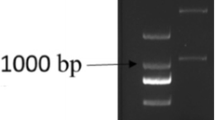Abstract
A total of 20 putative strains ofErwinia amylovora originating from 11 samples of host plants with symptoms of fire blight were analyzed in detail using commercial polyclonal antibodies in immunochemical tests. Fourteen strains reacted negatively in all tests; 6 strains reacted positively with a polyclonal antibody for PTA-ELISA (plate-trapped antigen-enzyme linked immunosorbent assay) at a concentration corresponding toA 620=0.1, while atA 620 readings of 0.01 and 0.001 the results were negative. Five strains reacted positively with a polyclonal antibody for indirect immunofluorescence test at all tested concentrations. Three of those strains were positive in the PCR test with AMSbL and AMSbR primers designed for detection ofE. amylovora. In hypersensitivity test in tobacco and in immature pear fruit assay, all putative strains were negative while a known reference strain ofE. amylovora gave a typical hypersensitive-reaction response. On a medium with 5% sucrose the reference strain ofE. amylovora produced levan while putative strains did not. After modification of the PCR protocol, 3 putative strains reacted as negatives. Optimization of PCR test was achieved by finding the optimum annealing temperature and time for primers. The recommended annealing temperature (49 °C) for these primers was increased to 55 °C and the annealing time was reduced from 2 min to 30 s. Using the microbial identification systemBiolog those 3 strains were identified asPantoea dispersa (1 strain) andPantoea agglomerans (2 strains). The strains are supposed to be white variants of the speciesP. dispersa andP. agglomerans occurring less frequently than the yellow variants. Since there were positive reactions in our immunochemical tests these strains could cause false positives in routine screening of plant samples.
Similar content being viewed by others
Abbreviations
- HR:
-
hypersensitive reaction
- IF:
-
immunofluorescence
- PTA-ELISA:
-
plate-trapped antigen-enzyme linked immunosorbent assay
References
Bereswill S., Pahl A., Bellemann P., Zeller W., Geider K.: Sensitive and species-specific detection ofErwinia amylovora by polymerase chain reaction analysis.Appl.Environ.Microbiol.58, 3522–3526 (1992).
Bereswill S., Bugert P., Bruchmueller I., Geider K.: Identification of the fire blight pathogen,Erwinia amylovora, by PCR assays with chromosomal DNA.Appl.Environ.Microbiol.61, 2636–2642 (1995).
EPPO/CABI: Quarantine Pests for Europe, 2nd ed., pp. 1001–1007 (J.M. Smith, D.G. Mc Namara, P.R. Scott, M. Holderness, Eds). European and Mediterranean Plant Protection Organization-CAB International, Wallingford (UK) 1997.
Falkenstein H., Bellemann P., Walter S., Zeller W., Geider K.: Identification ofErwinia amylovora, the fireblight pathogen, by colony hybridization with DNA from plasmid pEA29.Appl.Environ.Microbiol.54, 2798–2802 (1988).
Fousek J., Mráz I.: Determination of genetic differences between fluid and nonfluid variants ofClavibacter michiganensis subsp.sepedonicus using rep-PCR technique.Folia Microbiol.48, 682–686 (2003).
Geier G., Geider K.: Characterization and influence on virulence of the levansucrose gene from the fire blight pathogenErwinia amylovora.Physiol.Mol.Plant Pathol.42, 387–404 (1993).
Gorris M.T., Cambra M., Llop P., López M.M., Lecomte P., Chartier R., Paulin J.P.: A sensitive and specific detection ofErwinia amylovora based on the ELISA-DASI enrichment method with monoclonal antibodies.Acta Hortic.411, 14–45 (1996).
Hu X., Lai F.M., Reddy A.S.N., Ishimaru C.A.: Quantitative detection ofClavibacter michiganensis subsp.sepedonicus by competitive polymerase chain reaction.Phytopathology85, 1468–1473 (1995).
Jones J.B., Chase A.R., Hariss G.K.: Evaluation of theBiolog GN microplate system for identification of some plant-pathogenic bacteria.Plant Dis.77, 553–558 (1993).
Klement L., Rudolph K., Sands D.S.: Inoculation of plant tissues, pp. 101–102 inMethods in Phytobacteriology, Part I. Identification/Diagnosis. Akadémiai Kiadó, Budapest (Hungary) 1990.
Krejzar V., Kokošková B.:Erwinia amylovora — Biochemische Identifizierung mit derBiolog System, pp. 170–171 inBeitr. 2. Symp. Phytomedizin und Pflanzenschutz im Gartenbau, Wien (Austria) 1999.
Miller T.D., Schroth M.N.: Monitoring the epiphytic population ofErwinia amylovora on pear with a selective medium.Phytopathology62, 1175–1182 (1972).
OEPP/EPPO: Quarantine procedures — 40.Erwinia amylovora — sampling and test methods.OEPP/EPPO Bull.22, 225–232 (1992).
Pánková I.: Biochemical, immunochemical and antagonistic properties of epiphytic population ofPantoea agglomerans.PhD Thesis. Institute of Chemical Technology, Prague 1999.
Pánková I., Kokošková B.: Sensitivity and specificity of monoclonal antibody Mn-Cs1 for detection and determination ofClavibacter michiganensis subsp.sepedonicus, the causal agent of bacterial ring rot of potato.Plant Protect.Sci.38, 117–124 (2002).
Pánková I., Mráz I., Petrzik K.: Determination of optimal concentration ofErwinia amylovora andPantoea agglomerans antigens in the slide agglutination reaction.Plant Protect.Sci.34, 59–62 (1998).
Roberts P.: Problems encountered during immunofluorescent diagnosis of fireblight.Plant Pathol.29, 93–97 (1980).
Steinbrenner B., Zeller W., Bellemann P., Geider K.: DNA-hybridization, a specific method for diagnosis of fire blight.Acta Hortic.(Wageningen)273, 91–93 (1990).
Van der Zwet T., Beer S.V.:Fire Blight — Its Nature, Prevention, and Control. A Practical Guide to Integrated Disease Management. Agricultural Information Bulletin no. 631. US Department of Agriculture, Washington (DC) 1991.
Zielke R., Schmidt A., Naumann K.: Comparison of different serological methods for the detection of the fire blight pathogen,Erwinia amylovora (Burrill)Winslow et al.Zbl.Mikrobiol.148, 379–391 (1993).
Author information
Authors and Affiliations
Corresponding author
Additional information
This work was supported by project M01-01-03 of theMinistry of Agriculture of the Czech Republic.
Rights and permissions
About this article
Cite this article
Kokošková, B., Mráz, I. Reliability of diagnostic techniques forErwinia amylovora, the causative agent of fire blight disease. Folia Microbiol 50, 217–221 (2005). https://doi.org/10.1007/BF02931569
Received:
Revised:
Issue Date:
DOI: https://doi.org/10.1007/BF02931569




